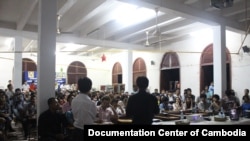Chhay Karno knew he wanted to be an architect when he was in Grade 10, drawing motivation from relatives, who worked as engineers.
He pursued his dream all the way through his bachelor’s degree at the Royal University of Fine Arts (RUFA) in Phnom Penh, and during further study at Chiang Mai University in northern Thailand.
In 2008, after gaining a master’s degree, he returned to lecture at RUFA, and went on to become the deputy dean of the school’s Faculty of Architecture.
Besides lecturing, Karno, now 38, has designed tourist resorts, hotels, schools and villas. He is now working on a plan for a new Western International School building, as well as a hotel in Sihanoukville.
Cambodia’s greatest living architect, Vann Molyvann—who designed most of Phnom Penh’s iconic structures—has been his main inspiration, he told VOA Khmer.
“I am inspired by Molyvann’s architecture style,” he said. “I am inspired a lot by him in terms of modern Cambodian architecture.”
But in recent years Karno also had a chance to be influenced by another great modern architect.
In 2012, Zaha Hadid was approached by Youk Chhang of the Documentation Center of Cambodia (DC-Cam) to design a center that would promote learning and remembrance of the atrocities committed by the Khmer Rouge.
She accepted, and her firm, Zaha Hadid Architects, set up a working group to develop the design for what will be known as the Sleuk Rith Institute. Karno linked up with the working group as a coordinator.
“It was a golden chance,” said Karno. “This was the first time that a world famous architect worked in Cambodia.
“I was very interested since I thought that Cambodia could get a piece of modern architecture in the next decade.”
Karno gave a presentation to Hadid’s working group about the history of Khmer architecture. He organized for about 50 students to work as interns on the project, and they had a unique opportunity to learn from Zaha Hadid’s team, he said.
“It is a good chance for the university to help design a significant building, which will represent humanity and history,” he said. “I think after being built, the Sleuk Rith Institute will make Phnom Penh, and the Cambodian nation, proud because it is an amazing design.”
Those involved say the project is still going ahead, although finding a company capable of realizing Zaha Hadid’s ambitious design—complete with the curves for which her work is known—poses a challenge.
Karno said he was hopeful that, despite Hadid’s death, she will have had a positive impact on Cambodia, despite never having visited the country.
“Zaha Hadid is the leader. If this project is successfully built, there will be more well-known architects that come to [Cambodia],” he said.
DC-Cam’s Youk Chhang said Zaha Hadid’s architectural vision will stay with Cambodia as young architects will learn about her unique style and try to adapt it.
“Her vision is still with us,” he said. “She is outstanding because she has a vision, and because of her curves. When it comes to curves, no one in the world could initiate the curving style like she did.”
Phuong Sophean, a secretary of state at the Ministry of Land Management, agreed that Zaha Hadid would influence home-grown designers.
“Architects adopt ideas, theories and principals from other architects who have different view on architecture,” he said.
“After young architects learn all these, they have to form their own wisdom and knowledge in order to construct buildings according to the environment and their own view on architecture.”
For his part, Karno couldn’t say for sure how Hadid’s brief involvement with Cambodian architecture would impact local architects, like his students. But, he said, it might at least raise awareness of the importance of their work.
“It will make Cambodians realize more the value of architectural design in the nation—that architectural design is crucial,” he said. “Architecture in the county will be more valued, and they will be more proud.”











